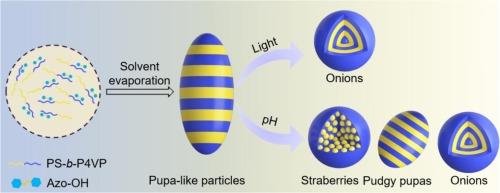pH and light-triggered shape transformation of block copolymer particles in emulsion droplets
IF 5.8
2区 化学
Q1 POLYMER SCIENCE
引用次数: 0
Abstract
Dual-responsive shape-transformable block copolymer (BCP) particles have arisen great attentions because of their tunable physical and chemical characteristics triggered by external stimuli. Herein, we developed a simple yet effective strategy to realize pH and light dual-triggered shape-switchable BCP particles through the co-assembly of BCPs with photo-responsive additive 4-hydroxyazobenzene (Azo-OH) within the evaporation emulsion droplets. The formation of hydrogen bonding interactions between the Azo-OH and 4-vinylpyridine (4VP) unit increases the volume fraction of P4VP domain, in turn leading to a morphological transition of the particles from onions to pupas by tuning the Azo-OH content. Subsequent light-induced trans–cis transition of the Azo unit induces the enhancement of the hydrophilicity of the P4VP domains, giving rise to internal shape transitions of the BCP particles from pupas to onions with P4VP at the outmost-layer. Furtherly, since the hydrogen bonds between Azo-OH and 4VP group are sensitive to pH, the interfacial properties of the emulsion droplets and the assembled structures are tuned through adjusting the environment pH of the aqueous solution, causing the formation of various particle shape, including pupas, raspberries, and onions. This work offers a promising method to engineer the microstructures of polymeric assemblies, which may attract more attention on the applications of the stimuli-responsive particles.

乳液液滴中嵌段共聚物颗粒在 pH 值和光线触发下的形状变化
双响应形状可变嵌段共聚物(BCP)颗粒因其在外部刺激下可调的物理和化学特性而备受关注。在此,我们开发了一种简单而有效的策略,通过在蒸发乳液液滴中共同组装含有光响应添加剂 4-羟基偶氮苯(Azo-OH)的嵌段共聚物,实现 pH 和光双重触发的形状可变嵌段共聚物颗粒。偶氮-OH 与 4-乙烯基吡啶(4VP)单元之间形成的氢键相互作用增加了 P4VP 结构域的体积分数,进而通过调节偶氮-OH 的含量实现了颗粒从洋葱到蛹的形态转变。随后,光诱导的偶氮单元反式-顺式转变会增强 P4VP 结构域的亲水性,从而导致 BCP 粒子的内部形状从蛹转变为洋葱,P4VP 位于最外层。此外,由于 Azo-OH 和 4VP 基团之间的氢键对 pH 值很敏感,因此可通过调节水溶液环境的 pH 值来调整乳液液滴和组装结构的界面特性,从而形成不同的颗粒形状,包括蛹、树莓和洋葱。这项工作提供了一种很有前景的方法来设计聚合物组装体的微结构,可能会引起人们对刺激响应粒子应用的更多关注。
本文章由计算机程序翻译,如有差异,请以英文原文为准。
求助全文
约1分钟内获得全文
求助全文
来源期刊

European Polymer Journal
化学-高分子科学
CiteScore
9.90
自引率
10.00%
发文量
691
审稿时长
23 days
期刊介绍:
European Polymer Journal is dedicated to publishing work on fundamental and applied polymer chemistry and macromolecular materials. The journal covers all aspects of polymer synthesis, including polymerization mechanisms and chemical functional transformations, with a focus on novel polymers and the relationships between molecular structure and polymer properties. In addition, we welcome submissions on bio-based or renewable polymers, stimuli-responsive systems and polymer bio-hybrids. European Polymer Journal also publishes research on the biomedical application of polymers, including drug delivery and regenerative medicine. The main scope is covered but not limited to the following core research areas:
Polymer synthesis and functionalization
• Novel synthetic routes for polymerization, functional modification, controlled/living polymerization and precision polymers.
Stimuli-responsive polymers
• Including shape memory and self-healing polymers.
Supramolecular polymers and self-assembly
• Molecular recognition and higher order polymer structures.
Renewable and sustainable polymers
• Bio-based, biodegradable and anti-microbial polymers and polymeric bio-nanocomposites.
Polymers at interfaces and surfaces
• Chemistry and engineering of surfaces with biological relevance, including patterning, antifouling polymers and polymers for membrane applications.
Biomedical applications and nanomedicine
• Polymers for regenerative medicine, drug delivery molecular release and gene therapy
The scope of European Polymer Journal no longer includes Polymer Physics.
 求助内容:
求助内容: 应助结果提醒方式:
应助结果提醒方式:


